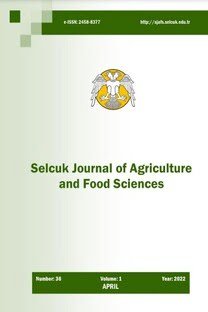Patojen olmayan fusarium türleri ile domateste Fusarium kök çürüklüğü hastalığının biyolojik kontrolü üzerinde bir araştırma
domates, kök çürükçülleri, biyolojik kontrol, Fusarium, bitki hastalıkları kontrolü, izolasyon
Investigation on the biological control of fusarium root rot in tomato by nonpathogen Fusarium spp.
tomatoes, root rots, biological control, Fusarium, plant disease control, isolation,
___
- Alabouvette, C., Lemanceau, P., Steinberg, C., 1993. Recent advances in the biological control of Fusa-rium wilts. Pestic. Sci., 37, 365 – 373.
- Benhamou, N., Lafontaine, P.J., Nicole, M., 1994. Induction of systemic resistance to Fusarium crown rot in tomato plants by seed treatment with chitosan. Phytopathology 84, 1422-1444.
- Burgess, L.M., Liddell, CM., Summerell, B.A., 1998. Laboratory Mannual for Fusarium Research. 2nd ed. Univ. Sydney, Australia, p. 156
- Cal, A. de., Garcia-Lepe, R., Melgarejo, P., 2001. Differential colonization of tomato roots by nonpa-thogenic and pathogenic Fusarium oxysporum strains may influence Fusarium wilt control. Phy-topathology. 91, 5: 449-456.
- Eparvier, A., Alabouvetter, C., 1991. Population dy-namics of non-pathogenic Fusarium and fluores-cent Pseudomonas strains in rockwool, a sobstrate for soilless culture. FEMS Microbial Ecol., 86, 177-184.
- Eparvier, A., Alabouvetter, C., 1994. Use of ELISA and GUS-transformed strains to study competition between pathogenic and nonpathogenic Fusarium oxysporum for root colonization. Biocontrol Sci. &Techo, 4, 35-47.
- Fuchs, J.G., Moenne-Loccoz, Y., Dfago, G., 1997. Non-pathogenic Fusarium oxysporum strain Fo47 induces resistance to Fusarium wilt of tomato. Plant Dis., 81, 492-496.
- Ishiba, C, Tani, T., Murata, M., 1981. Protection of cucumber against anthracnose by hypovirulent strains of Fusarium oxysporum f.sp. cucumerinum. Ann. Phytopathol. Soc. Jpn., 47: 352-359.
- Kloepper, J.W., Leong, J., Teintze, M., Schroth, M.N., 1980. Pseudomonas siderophores: a mechanism explaining disease-suppressive soils. Curr. Micro-biol., 4, 317-320.
- Komado, H.,1996. Biocontrol of tomato by previous inoculation with nonpathogenic Fusarium oxyspo-rum in soilness culture. First International Fusa-rium Biocontrol Workshop, Bletsville, Oct, 28-31, pp. 35.
- Larkin, R.P., Hopkins, D.L., Martin, F.N., 1993. Ef-fect of successive watermelon planting on Fusa-rium oxysporum and other microorganisms in soil suppressive and conducive to Fusarium wilt of wa-termelon. Phytopathology, 83, 1097-1105.
- Lemanceau, P., Alabouvette, C.,1991. Biological control of Fusarium diseases by fluorescent Pseu-domonas and nonpathogenic Fusarium. Crop. Prot. 10, 279 -286.
- Louter, J.H., Edgington, I.V., 1990. Indication of cross-protection against Fusarium crown rot of tomato. Can. J. Plant Pathol., 12, 283-288.
- Minuto, A., Migheli, Q., Garibaldi, A., 1995. Evalua-tion of antagonistic strains of Fusarium spp. in the biological and integrated control of Fusarium wilt of cyclamen. Crop Protection 14 (3):221-226.
- Minuto, A., Minute, G., Mihheli, Q. Mocioni, M., Gullino, M.L., 1997. Effect of antagonistic Fusa-rium spp. and of different commercial biofungicide formulations on Fusarium wilt of basil (Ocimıım basilicum L.). Crop Protection 16 (8):765-769.
- Nelson, P.E., Toussoun, T.A., Marasas, W.F.O., 1983. Fusarium species: An Illustrated Manual for Iden-tification. Pennsylvania State University Press, University Park.
- Ogawa, K., Watanable, K., Komada, H., 1996. Formu-lation of nonpathogenic Fusarium oxysporum, a biocontrol agent for commercial use. First Interna-tional Fusarium Biocontrol Workshop, Bletsville, (1996), Oct, 28-31. p. 34.
- Scher, F.M., Baker, R., 1980. Mechanism of biologi-cal control on Fusarium-suppressive soil. Phytopa-thology, 70, 412-417.
- Sesan, T., Oprea, M., Baicu, T., 1993. Studies on the mycoparasitic fungus Fusarium lateridium Nees [Gibberella baccata (Wallr.) Sacc.], Biological control agent to be used against plant pathogenic fungi. Stud. Cerac. Biol. Vegetal., 44, 85-192.
- Smith, S.N., Snyder, W.C., 1971. Relationship of inoculum density and soil types to severity of Fu-sarium wilt of sweet potato. Phytopathology, 61, 1049-1051.
- Sneh, B., 1998. Use of non-pathogenic or hypoviru-lent fungal strains to protect plants against closely related fungal pathogens. Biotechnology, 16(1): 1-32.
- Tamietti, G., Ferraris, L., Matta, A. And Gentile, I.A., 1993. Physiological responses of tomato plants grown in Fusarium suppressive soil. J. Phytopa-thol., 138, 66-76.
- Tezuka, N., Makino, T., 1992. Biological control of Fusarium wilt of strawberry by nonpathogenic Fu-sarium oxysporum isolated from strawberry. Ann. Phytopathol. Soc. Jpn., 57, 506-511.
- ISSN: 1300-5774
- Yayın Aralığı: Yılda 3 Sayı
- Başlangıç: 2018
- Yayıncı: Selçuk Üniv. Ziraat Fak.
Konya ili tarıma dayalı sanayi işletmelerinde tamamlayıcı ithalatın etkisi
ZEKİ BAYRAMOĞLU, MEHMET ERDEMİR GÜNDOĞMUŞ
FAHRİ YİĞİT, Keziban ARIKAN, Yasemin Y. BALABAN
Cihan UZUN, H. Hüseyin ÖZAYTEKİN
Mustafa ÜLGÜ, İskender YILDIRIM
Yağlı kuyruklu ve yağsız ince kuyruklu koyun ırklarının besi performanslarının karşılaştırılması
Ereğli yöresi süt sığırı barınaklarının yapısal durumu ve sorunları
Van ili Erciş ilçesinde patates yetiştiriciliğinin durumu üzerine bir araştırma
Murat TUNÇTÜRK, Kasım ŞAHİN, TAMER ERYİĞİT
A new anise (Pimpinella anisum L.) pest: Carterus dama (Rossi, 1792) (Coleoptera: Carabidae)
ERHAN KOÇAK, Memiş KESDER, EROL YILDIRIM
ALPER DARDENİZ, KENAN KAYNAŞ, Bahar GÜMÜŞ, Mustafa NAZLIM, İlker KIZLCIK
